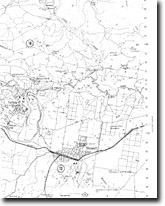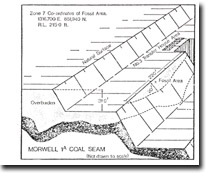13. La Trobe Valley Tertiary Brown Coal Deposits
|
This information has been developed from the publications:
|
| Location: | (Morwell Open Cut) (Yallourn Open Cut) | |
Access: | By arrangement with the S.E.C. Coal Production Division, Morwell Open Cut. | |
Ownership: | State Electricity Commission. | |
Geology/Geomorphology: | The Morwell Formation, a complex late Oligocene to early Miocene unit of thick brown coal seams with subordinate interseam sediments, is widespread in the La Trobe Valley Depression, the Haunted Hill Block and the Moe Swamp Basin. The thickness near the Morwell Open Cut of the unit is 150 metres to 180 metres, increasing to 210 metres near Gormandale. Near Morwell the oldest coal seam, the La Trobe Seam, splits into the Morwell 2 Seam below and the Morwell IB Seam above. This joins a younger seam, the Morwell IA, to form the thick Morwell I Seam which is mined at the Morwell Open Cut. Overlying the Morwell Formation in the La Trobe Valley Depression is the youngest unit of the coal measures sequence, the Yallourn Group of middle to late Miocene age. The Yallourn Open Cut, where the Yallourn Seam is mined, may be designated as the type area. The lower part of the Yallourn Group consists of up to 120 metres of clay, sand and, near Morwell, local thin coal seams called the Morwell IO Seam. The overlying Yallourn Seam is up to 97 metres thick, and near the La Trobe River is overlain by another unnamed seam up to 16 metres thick. Post-Yallourn Seam sediments are present in the deeper synclinal areas where they may attain 100 metres in thickness. These deposits, the Haunted Hill Gravel Formation, are referred to as the gravel, sand and clay “overburden” of the coal measures in the La Trobe Valley Depression. The age of the formation is considered to be largely late Pliocene to early Pleistocene. | |
Significance: | National and International. The Morwell open cut includes the type section of the Morwell Formation Coal Measures and the associated overburden sediments. The Yallourn open cut contains the type section of the Yallourn Formation. | |
Management: | Excavation and widening of the brown coal open cut mines is consistent with the preservation of clear and unweathered sections of the La Trobe Valley Coal Measures. Several areas should be selected and reserved by the S.E.C. to display the thickness and structure of the Coal measures and the stratigraphy of the overburden and the underlying materials. The selection of these sites has not been attempted in this report as it is a matter for the engineering and geological staff of the S.E.C, taking into consideration the operation of the open cut mine. Four sites which display features of the coal and associated sediments are described below. | |
| a. | ||
| Location: | 465668. adjacent to No. 3 Transfer House on the east batters of No. 1 level, Northwest Morwell Open Cut. | |
Geology: | Ligneous clays and thinly bedded, laminated blank shales of late Tertiary age infill a depression produced by a fire on the surface of the Morwell 1A sea. Brackish water sediments accumulated in this depression and contain a variety of fossil remains. There are impressions of eucalypt leaves, and two fossil fish and fish scales have been recovered. There are also numerous diatoms and sponge spicules and pollen grains. Other fossils collected from the lower strata of the hollow are numerous ostracodes of the genus Mytilocypris. | |
Significance: | International. This is the only locality from which vertebrate fossils have been collected from the La Trobe Valley Coal Measures. | |
Management: | The S.E.C. should continue to limit access to the site to prevent overcollecting of fossil material. They should also ensure that no building construction is permitted that would damage or obscure the site. | |
References: | Waldman, M and Handby, P.L., (1968): Tertiary fish from Morwell, Victoria. Proc. R. Soc. Vict., 81(2), pp. 95-96. | |
| ||
| Location: | 466660. Western Batters, Morwell Open Cut overburden level. | |
Geology: | The Western Batters of the Morwell Open Cut expose sediments of the Haunted Hill Gravels overlying brown coal deposits. | |
Significance: | International. Fresh unweathered exposures of the total thickness of the Haunted Hill Gravels displaying large-scale bedding and depositional features are not usually preserved in road cuttings and quarries in the study area. | |
Management: | Excavation of the overburden is consistent with the maintenance of sections through the Haunted Hill Gravel, displaying the relationship between the sediments and the underlying brown coal. However, a representative section should be reserved for display. | |
| ||
| Location: | 466660. north-western batters, Morwell Open Cut. | |
Geology: | Preserved in these "permanent" (i.e unworked) coal batters immediately adjacent to the Morwell township, is the interlensing of the Yallourn Seam overlying the Morwell IO Seam and underlying clays and silts, which rests on cross-bedded fine sands at the top of the Morwell IA Seam. | |
Significance: | International. This is the best exposure of the La Trobe Valley Coal Measures and interseam sediments in the upper part of the sequence. | |
Management: | The S.E.C. should maintain the clarity of the exposure by occasional slope grooming of the batters and the removal of weathered surfaces of the batters by scraping. | |




